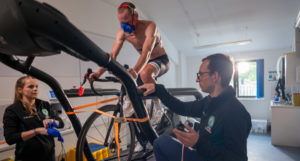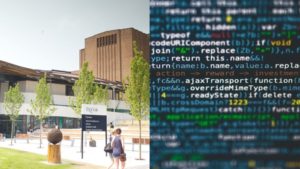From square to cube: AI hardware processes data in higher dimensions

credit: Dr B Dong / University of Oxford
In a paper published today in Nature Photonics, researchers from the University of Oxford, along with collaborators from the Universities of Muenster, Heidelberg and Exeter, report on their development of integrated photonic-electronic hardware capable of processing three-dimensional (3D) data, substantially boosting data processing parallelism for AI tasks.
While conventional computer chip processing efficiency doubles every 18 months, the processing power required by modern AI tasks is currently doubling around every 3.5 months. In order to meet this demand, new computing paradigms are needed.
The researchers previously looked at using light instead of electronics to meet make this breakthrough, allowing multiple calculations to be carried out in parallel using different wavelengths to represent different sets of data.
Now the team has gone further by adding an extra parallel dimension to the processing capability of their photonic matrix-vector multiplier chips. This “higher-dimensional” processing is enabled by exploiting multiple different radio frequencies to encode the data, propelling parallelism to a level far beyond that previously achieved.
The team applied their new hardware to the task of assessing the risk of sudden death from electrocardiograms of heart disease patients. They were able to successfully analyse 100 electrocardiogram signals simultaneously, identifying the risk of sudden death with a 93.5% accuracy.
First author Dr. Bowei Dong at the Department of Materials, University of Oxford said: “We previously assumed that using light instead of electronics could increase parallelism only by the use of different wavelengths – but then we realised that using radio frequencies to represent data opens up yet another dimension, enabling superfast parallel processing for emerging AI hardware.”
Professor Harish Bhaskaran, Department of Materials, University of Oxford who led the work said, “This is an exciting time to be doing research in AI hardware at the fundamental scale, and this work is one example of how what we assumed was a limit can be further surpassed.”
Prof David Wright from the Department of Engineering at the University of Exeter also pointed out that the team’s concepts for photonic computing have been developed thanks to support from a number of EU grants including the Horizon 2020 PHOENICS project (Grant No. 101017237) led by Prof Wolfram Pernice at the University of Heidelberg, and the EU Innovation Council Pathfinder project HYBRAIN (Grant No. 101046878). “Without such support – and European-wide collaborations” said Prof Wright “advances such as reported in this paper would be immensely more difficult to achieve”.
The full paper, ‘Higher-dimensional processing using a photonic tensor core with continuous-time data’, is published in Nature Photonics.



